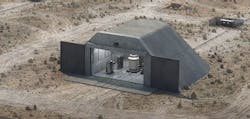As SMRs Stumble, Will Microreactors Find a Home In the Data Center Industry?
While a subset of the small modular reactor (SMR) market - which, at least in the U.S., is having a year fraught with setbacks and intrigue laced with innuendo (if not exactly peril) - the concept of microreactors isn’t a new one.
When it comes to microreactors, people tend to think of the nuclear-powered military vessels that the US has deployed since 1955, since the largest navel vessel is still smaller than the footprint of a commercial nuclear power plant.
But the actual issue isn’t quite as obvious. While both microreactors and marine nuclear reactors utilize nuclear power, they differ in terms of size, power output, design, operation, fuel efficiency, application, and costs.
After all, at the very least, a marine power plant is built into the ship and has constant crew monitoring and maintaining the unit.
The goal of commercially deployed microreactors leans more towards the battery model; plug it in until it can’t provide power any longer, then swap it for a new one.
What’s Driving this Development?
Much of the impetus behind the development of commercial microreactors is coming from the US Department of Defense Project Pele, a program initiated in 2016 after the Defense Science Board identified energy as a “critical enabler of future military operations.”
The technology also meets the current demands being placed on energy providers in a sustainable, carbon-free way - especially when you consider that the current DoD energy requirement is approximately 30 terawatt-hours of electricity per year, and over 10 million gallons of fuel per day.
Project Pele will contribute to both energy resiliency and carbon emission reduction efforts. While there were multiple competitors for the project funding, the DoD awarded BWX Technologies a $300 million contract to design, complete, and deliver the reactor.
The reactor is being assembled in Lynchburg, Tennessee over the course of 2024, and is expected to be shipped to Idaho National Laboratory (INL) in early 2025.
Other competitors for the contract continue to work on the development of their own microreactor designs. Each of the designs has a number of factors in common:
- Each design is transportable and inherently safe, meaning that the reactor can be moved and operated under a variety of conditions.
- Each design utilizes High-Assay Low Enriched Uranium (HALEU) Tristructural Isotropic (TRISO) fuel, making it a fourth-generation nuclear reactor. Its potential applications extend beyond merely generating electricity; it could also be used for heating, chemical processes, desalination, and producing synthetic aviation fuel, all of which can be utilized by both the military and commercial applications.
- Each design's inherent energy efficiency and carbon reduction elements address two major needs of the energy generation model.
- Each design supports autonomous operation with safety oversight. While there will still be onsite safety and operations management, it will be a significant reduction from the current staffing model for nuclear power generation.
The BWXT Advanced Nuclear Reactor is expected to be a a modular, factory built system that is small and light enough to be moved via truck or rail and deliver up to 50 MW of energy.
BWXT is working on the project at their Lynchburg, Virginia facility, where they are also working on the space-bound reactor for DRACO, the DARPA/NASA collaboration on nuclear propulsion for spacecraft.
What Else is Happening?
Not getting initial funding from the government hasn’t stopped other entities from competing in the microreactor market.
This week, Westinghouse Nuclear, who has been building reactors for almost 70 years, announced that the government of Saskatchewan will the the first customer for its eVinici microreactor.
The Saskatchewan Research Council, a Saskatchewan government Treasury Board Crown Corporation that serves as a commercial laboratory to provide research and development (R&D) for Saskatchewan industries, announced on November 27th plans to pilot the eVinici reactor by 2029.
The 5 MW deployment is designed to provide its fully rated power for no less than 8 years without refueling. The energy is carbon-free and requires no water for cooling or operation. Its footprint is entirely above ground and less than two acres.
The pilot's heat pipe technology design builds on the decades of experience that Westinghouse brings to the project, and is a significant simplification of the active design of current nuclear power plants.
Other vendors in the microreactor design stage include Nano Nuclear, X-Energy, Urenco, LeadCold, and UltraSafe Nuclear.
Should any or all of these projects meet their design goals, even low power versions could be a major upgrade for backup and microgrid power generation on a data center campus. The higher end power designs could be practical as power sources for entire data center deployments.
The following video from Westinghouse describes the company's accelerated investment in its eVinci microreactor heat-pipe technology. The video describes how a new facility, soon to open in Pittsburgh, will be dedicated to furthering the microreactor technology.
About the Author



